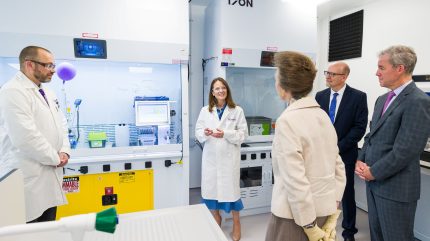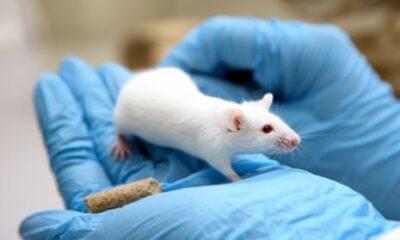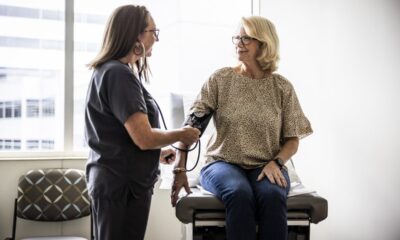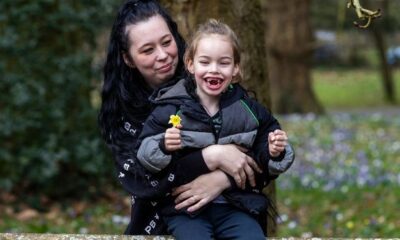Science
Insmed Launches Innovation Centre to Advance Genetic Therapies

Insmed, a US-based biopharmaceutical firm, has officially launched its innovation centre at the Babraham Research Campus in Cambridge, UK, marking a significant step in its pursuit of advanced genetic therapeutics. The facility, which spans 17,000 square feet, was inaugurated in mid-July 2025 with a ceremony attended by Her Royal Highness, The Princess Royal. This new hub is pivotal to Insmed’s strategic shift towards synthetic rescue, a revolutionary approach aimed at manipulating cellular pathways to restore normal function.
Leading this initiative is Dr Tom Heightman, Senior Vice President and Head of Research at the Cambridge site. With over 25 years of experience in the pharmaceutical industry, Heightman has previously held key positions at major companies such as GlaxoSmithKline and AstraZeneca. He played a crucial role in transforming Adrestia, which was acquired by Insmed in 2023. Heightman highlighted the synergy between the two companies, stating, “Our early-stage target discovery and drug discovery platform was well suited to Insmed because they wanted to invest some of their clinical success in building a longer-term pipeline.”
Innovative Approach to Rare Diseases
Synthetic rescue is positioned as the opposite of synthetic lethality, a concept prevalent in oncology. While synthetic lethality involves two gene disruptions that lead to cell death, synthetic rescue aims to identify alternative pathways that can restore health when a critical gene is compromised. Insmed’s platform combines whole-genome CRISPR screens, high-throughput validation, and extensive human genetic data analysis with computational drug design.
Heightman describes this combination as their “secret sauce.” He elaborated, “What makes this facility unique is two-fold. First, the synthetic rescue platform itself. Second, the ability to execute end-to-end drug discovery in one place: genetic discovery, data science, computational chemistry and wet-lab synthesis.” Although currently consisting of around 80 staff, Insmed has integrated various scientific disciplines under one roof, a rarity for a company of its size.
The focus of the Cambridge team is on rare genetic disorders, particularly those affecting the central nervous system and neurodegenerative diseases. Heightman noted, “Synthetic rescue has broad applicability. It’s why both Adrestia and the Insmed leadership were drawn to it.” With nearly 7,000 recognized rare diseases, many lacking a clear mechanistic understanding, traditional drug discovery methods can be ineffective. Instead, the Cambridge team is developing assays and cell models from the ground up to deepen their understanding of the underlying biology and the impact on patients.
Collaboration and Future Prospects
Insmed’s Cambridge facility complements its other research sites in San Diego, New Hampshire, and New Jersey, each specializing in different modalities. San Diego focuses on gene therapy, New Hampshire on biologics, and New Jersey on lipid-formulated small molecules. Heightman explained that these sites operate as semi-independent hubs with specific focuses but convene every six months for a cross-site symposium to share breakthroughs and foster collaboration.
The company is also planning to optimize the use of capital-intensive equipment across its research hubs to minimize redundancy and leverage advanced tools effectively. Heightman noted promising progress in various early-stage projects during the first half of 2025, with the current objective of generating preclinical data to advance discoveries toward potential prototype medicines. “We intend to make this scientific second half of the year very rich – more data, more clarity on molecules moving through preclinical development,” he expressed.
In addition to internal collaboration, Insmed is promoting interaction between researchers and clinicians. Heightman remarked, “We’re starting to see clinical teams ask us questions where someone within our research groups has the right expertise to help. So, there’s a valuable two-way exchange, rather than just one-way communication.”
While artificial intelligence (AI) increasingly plays a role in drug discovery, Heightman maintains a cautious perspective. He stated, “It works best in areas where we have deep datasets, so now we’re seeing success in specific, well-defined problems. The hope is that future generations of AI will be able to integrate different data types more holistically, but for now, I think we still need human scientists to drive the process.”
Despite facing operational losses, Insmed continues to support its ongoing projects, including brensocatib for bronchiectasis, which is being financed through public market fundraising. In June 2025, the company announced a public offering worth $750 million to fund research and commercialization, reflecting strong investor confidence in its direction.
As Insmed solidifies its position in the UK’s life sciences sector, its commitment to synthetic rescue represents a broader shift in the approach to genetic diseases. While the science is still in its nascent stages and significant challenges remain, Insmed’s strategy of consolidating diverse capabilities under one roof positions it to explore these complex questions effectively. The viability of synthetic rescue will ultimately depend on the data generated and how successfully these insights can be transformed into meaningful treatments for patients.
-

 Entertainment3 months ago
Entertainment3 months agoAnn Ming Reflects on ITV’s ‘I Fought the Law’ Drama
-

 Entertainment4 months ago
Entertainment4 months agoKate Garraway Sells £2 Million Home Amid Financial Struggles
-

 Health3 months ago
Health3 months agoKatie Price Faces New Health Concerns After Cancer Symptoms Resurface
-

 Entertainment3 months ago
Entertainment3 months agoCoronation Street’s Carl Webster Faces Trouble with New Affairs
-

 Entertainment2 weeks ago
Entertainment2 weeks agoCoronation Street Fans React as Todd Faces Heartbreaking Choice
-

 Entertainment3 months ago
Entertainment3 months agoWhere is Tinder Swindler Simon Leviev? Latest Updates Revealed
-

 World2 weeks ago
World2 weeks agoBailey Announces Heartbreaking Split from Rebecca After Reunion
-

 Entertainment4 months ago
Entertainment4 months agoMarkiplier Addresses AI Controversy During Livestream Response
-

 Science1 month ago
Science1 month agoBrian Cox Addresses Claims of Alien Probe in 3I/ATLAS Discovery
-

 Health5 months ago
Health5 months agoCarol Vorderman Reflects on Health Scare and Family Support
-

 Entertainment4 months ago
Entertainment4 months agoKim Cattrall Posts Cryptic Message After HBO’s Sequel Cancellation
-

 Entertainment3 months ago
Entertainment3 months agoOlivia Attwood Opens Up About Fallout with Former Best Friend





















